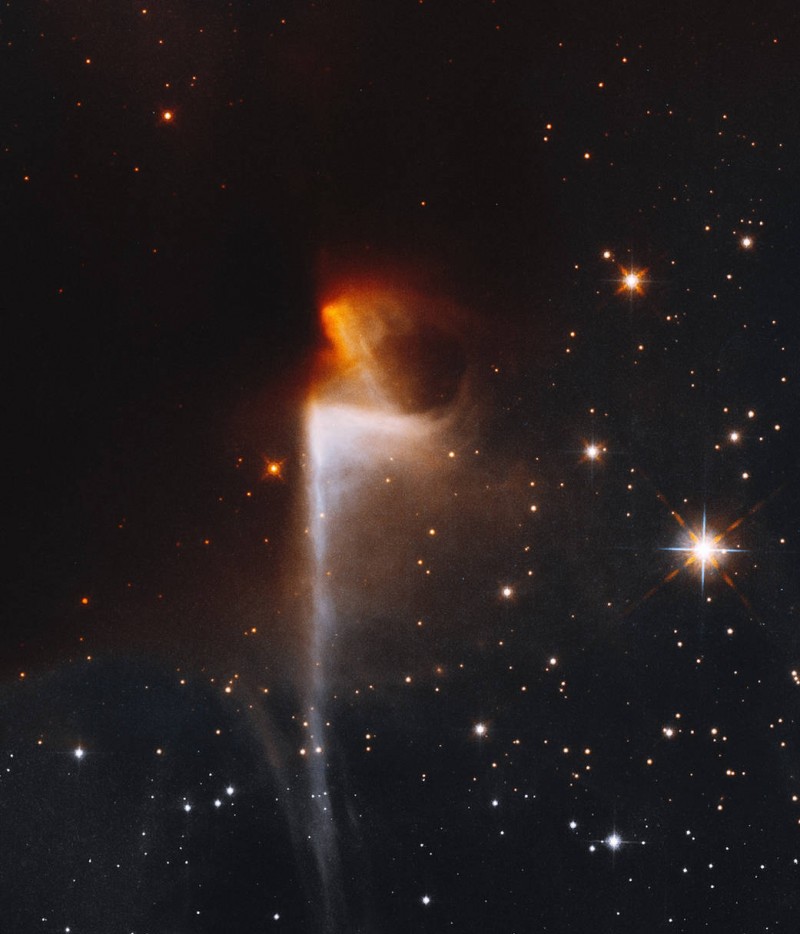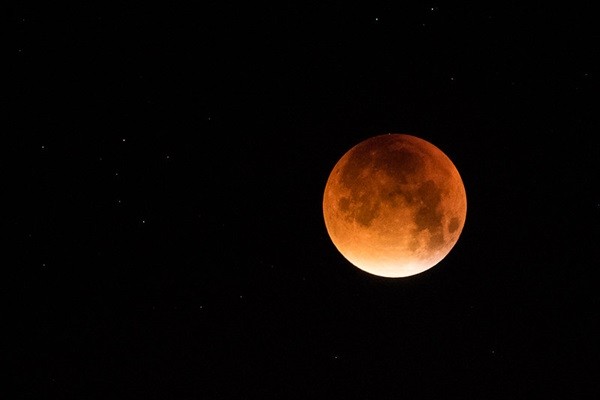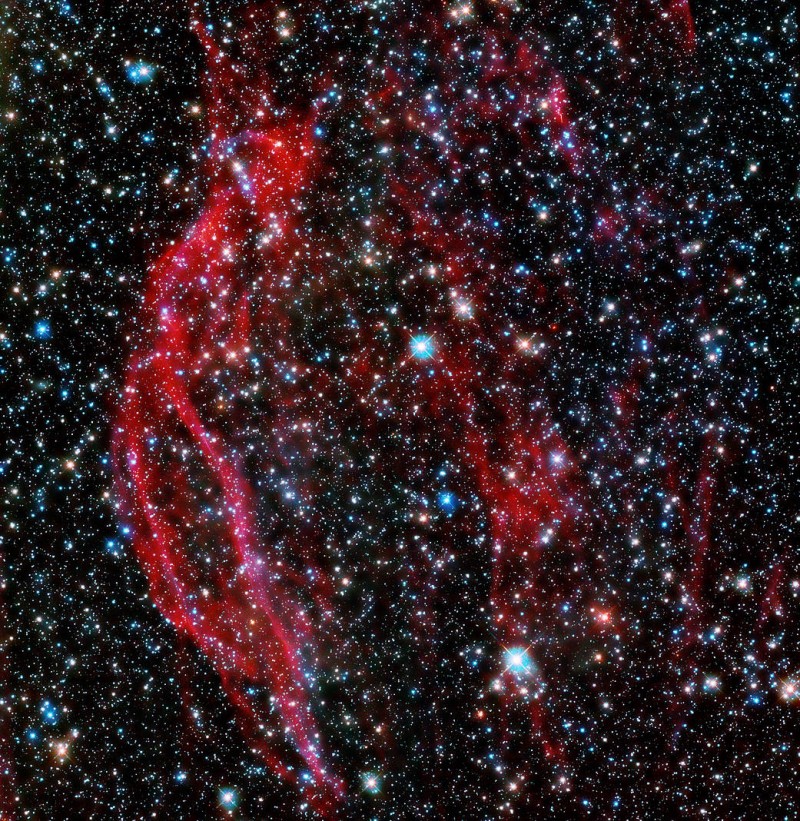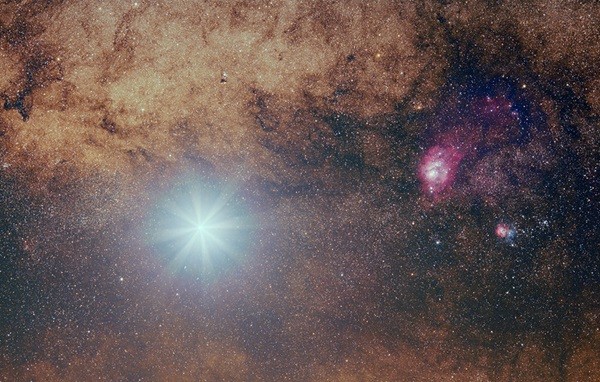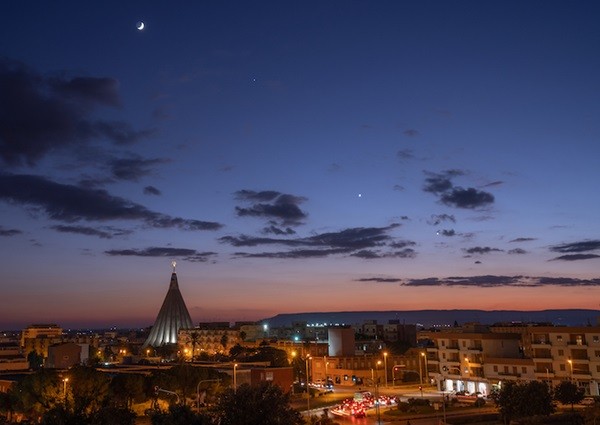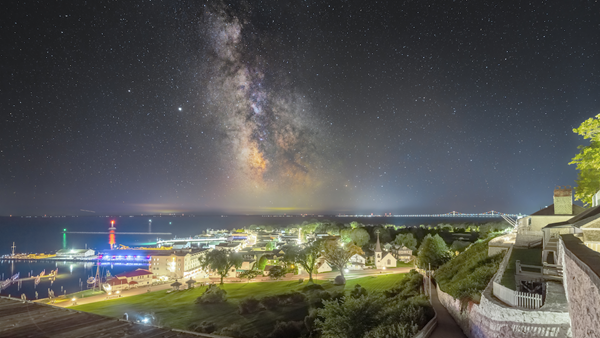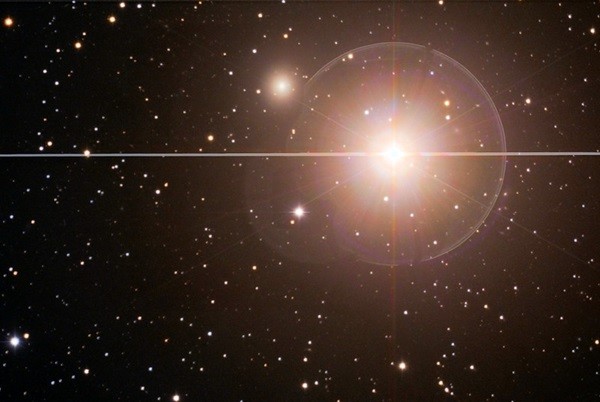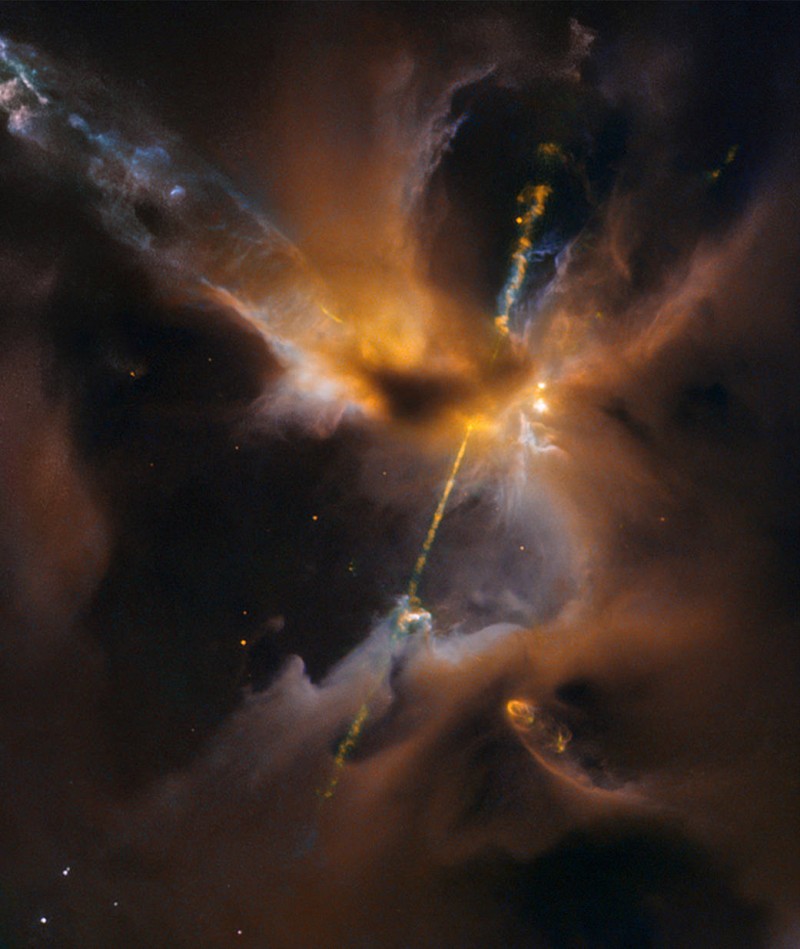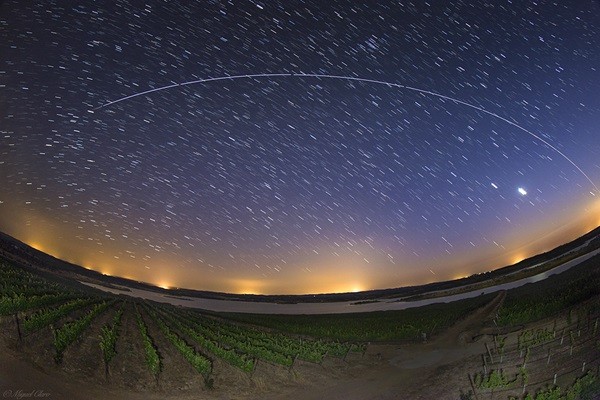Blog
Hubble Images Dark Nebula Cloaking Stars Within Dusty Depths
Monday, November 15th 2021 05:38 PM
This Hubble image captures a portion of a dark nebula in the constellation Cepheus. LDN 1165 is part of a collection called Lynds’ Catalog of Dark Nebulae, originally published in 1962. Dark nebulae – also called absorption nebulae – are clouds of gas and dust that neither emit nor reflect light, instead blocking light coming from behind them. These nebulae tend to contain large amounts of dust, which allows them to absorb visible light from stars or nebulae beyond them. Dark nebulae are so dark that they’ve been referred to as “holes in the sky,” but in reality they may be full of activity, with stars sometimes forming inside their dense clouds.
Hubble observed this region as part of a study of protostars, hot dense cores of newly forming stars that are accumulating gas and dust as they undergo the starbirth process. The bright area in this image is likely a star-forming region that may hold one or more young protostars. Further study of da...
Read More
Read More
The Sky This Week: Catch the century’s longest partial lunar eclipse
Friday, November 12th 2021 05:50 PM
The photographer captured this shot of the September 28, 2015, lunar eclipse from their balcony.
Friday, November 12
The Leonid meteor shower is still several days from its peak on the 17th, but that date unfortunately coincides with a nearly Full Moon. That means the next few days are instead your best bet for spotting any meteors associated with this weak shower, which is only expected to produce about 10 per hour above the sporadic background rate, even at its peak.
The Leonids’ radiant is located near 3rd-magnitude Adhafera in Leo the Lion. This region rises around local midnight and is highest closer to sunrise, making the few hours before dawn the best time to scan the skies for any stray streaks of light.
If you’re up late tonight waiting for Leo to peek above the horizon, take some time to enjoy some of the many autumn constellations now gracing the evening sky. Orion, Taurus, and Gemini are on full display before midnight, as are Auriga, Perseus...
Read More
Read More
Image of the Day - Mocha Swirls in Jupiter’s Turbulent Atmosphere
Thursday, November 11th 2021 05:21 PM
During its 36th low pass over Jupiter, NASA’s Juno spacecraft captured this view of striking cloud bands and swirls in the giant planet’s mid-southern latitudes. The dark, circular vortex near the center of the image is a cyclone that spans roughly 250 miles (about 400 kilometers). The color at its center is likely to be the result of descending winds that cleared out upper-level clouds, revealing darker material below.
Citizen scientist Brian Swift used a raw JunoCam image digitally projected onto a sphere to create this view. It has been rotated so that north is up. The original image was taken on Sept. 2, 2021, at 4:09 p.m. PDT (7:09 p.m. EDT). At the time, the spacecraft was about 16,800 miles (about 27,000 kilometers) above Jupiter’s cloud tops, at a latitude of about 31 degrees south.
JunoCam’s raw images are available for the public to peruse and process into image products. More information about NASA citizen science can be found on our NASA So...
Read More
Read More
Hubble Captures the Shredded Remains of a Cosmic Explosion
Tuesday, November 9th 2021 05:15 PM
These cosmic ribbons of gas have been left behind by a titanic stellar explosion called a supernova. DEM L249 is thought to be the remnant of a Type 1a supernova, the death of a white dwarf star. White dwarf stars are usually stable, but in a binary system – two stars orbiting each other – a white dwarf can gravitationally pull so much matter from its companion that it reaches critical mass and explodes.
DEM L249, located in the Large Magellanic Cloud, is an unusual supernova remnant. Astronomers using NASA's Chandra X-ray Observatory and the European Space Agency's XMM-Newton found its gas was hotter and shone brighter in the X-rays than the remnant of a typical Type 1a supernova. Astronomers suspect DEM L249’s white dwarf star was more massive than expected – heavier stars expel more gas – which also means it would have died earlier in its lifecycle.
Hubble took this image while searching for surviving companions of white dwarf stars that went...
Read More
Read More
The Sky This Week: Mercury meets Mars
Monday, November 8th 2021 05:28 PM
Venus and the Milky Way: Bright Venus slides through the star-studded the Milky Way near the Lagoon and Trifid nebulae in this stunning shot from November 2013. A similar sight awaits astroimagers this week.
Friday, November 5
The Moon reaches perigee, the closest point to Earth in its orbit around our planet, at 6:18 P.M. EDT. It will then sit 222,975 miles (358,843 km) away.
Fortunately for deep-sky observers, the Moon is also a tiny, 1-percent-lit crescent that sets shortly after the Sun, making tonight a great night for some fainter pursuits. Let’s try a famous one — the one, in fact, that “started it all” for Charles Messier, whose catalog of M-numbered objects we still use today as a guide for great targets.
M1, also known as the Crab Nebula, is a supernova remnant housing a rapidly spinning neutron star — called a pulsar — inside. Discovered in 1731 not by Messier, but by John Bevis, Messier spotted it independently nearly...
Read More
Read More
Sky This Month: November 2021
Friday, November 5th 2021 04:24 PM
Planets in the sky over Syracuse, Italy: From left to right, Saturn, Venus, and Jupiter trail the Moon above the Basilica Sanctuary of Our Lady of Tears in Syracuse, Italy. This month, the same planets will similarly stretch along the ecliptic.
Venus, Jupiter, and Saturn dominate the evening sky with lots of planetary action in November. Highlights include Venus’ quickly changing phase; Jupiter’s atmosphere, Great Red Spot, and Galilean moon transits; and Saturn’s stunning rings. Uranus reaches opposition and is on view all night, and for a bigger challenge, hunt down distant Neptune.
Venus visits the Lagoon: Astrophotographers won’t want to miss this shot: On Nov. 6, Venus sits less than 3° south of the Lagoon Nebula (M8).
Venus crosses into Sagittarius Nov. 1 and is visible within half an hour of sunset, low and bright in the southern sky. At magnitude –4.5, it is unmistakable. Venus crosses the broad swath of the Milky Way during...
Read More
Read More
Capturing the cosmos: How to be an astrophotographer
Thursday, November 4th 2021 04:29 PM
Fort Mackinac Milky Way. Imaging the Milky Way with any camera system presents a photographer with countless choices related to framing and target selection. In fact, it can be shot with almost any equipment, whether it be an advanced telescopic setup or simply your smartphone. This long-exposure shot of the Milky Way was captured from an old cannon platform at Fort Mackinac on Mackinac Island, Michigan, with the aid of a tracking mount. The view was then blended with a static ground shot of the town, harbor, and Mackinac Bridge in the distance.
Most novice astro-photographers have a defining moment, when they find themselves staring in disbelief at what they just recorded in their camera. For me, that moment came a decade ago, standing outside on my back patio with a new Canon Rebel T1i DSLR. Although dark skies will reveal the Andromeda Galaxy to the unaided eye, suburban light pollution had forced me to clumsily determine its location using star charts. Targeting our galact...
Read More
Read More
The Sky This Week: Catch some ghostly sights
Monday, November 1st 2021 04:11 PM
Mirach and its ghost: The bright star Mirach appears to have a ghostly companion, but in reality it is a tiny galaxy far beyond our own.
Friday, October 29
Venus reaches greatest eastern elongation (47°) from the Sun at 5 P.M. EDT. You’ll find the planet high in the southwestern sky after the Sun sets, blazing a bright magnitude –4.5.
Through a telescope, Venus spans 25" and still appears half-lit, having reached dichotomy (when it is exactly 50 percent lit) last week. As we move into November, the planet will remain bright, growing in angular size but shrinking in phase, appearing more crescentlike as the days go by.
Farther east along the ecliptic from Venus is Saturn, which sits 43.5° east of the brilliant planet and glows a much more muted magnitude 0.5. Still, Saturn is stunning through a telescope, showing off its famous ring system, which appears nearly 39" end to end.
Finally, 15.4° east of Saturn is magnitude –2.5 Jupiter. The...
Read More
Read More
Image of the Day: The Force Awakens in a Newborn Star
Tuesday, October 26th 2021 11:31 PM
This celestial lightsaber does not lie in a galaxy far, far away, but rather inside our home galaxy, the Milky Way. It's inside a turbulent birthing ground for new stars known as the Orion B molecular cloud complex, located 1,350 light-years away.
Image Credit: NASA/ESA
Read More
Read More
The Sky This Week: Spot the moment Venus reaches dichotomy
Monday, October 25th 2021 04:25 PM
The International Space Station above vineyards in Portugal: The ISS reflects light from the Sun, appearing as a slow-moving bright point against the background stars.
Friday, October 22
In the late 1700s, Charles Messier created his famous catalog to identify objects that he didn’t want to mistake for comets. Thus, most of the entries in his list are small and appear fuzzy at low power.
One such object is the globular cluster M72 in Aquarius the Water-bearer. Look south after dark tonight to find it about 3.4° south-southeast of magnitude 3.8 Epsilon (ϵ) Aquarii. It’s currently sitting between bright Jupiter (to its southeast) and Alpha (α) Capricorni to its southwest.
At magnitude 9.2, M72 is the faintest globular cluster — an old grouping of stars — in Messier’s catalog. You’ll need binoculars or a telescope to spot it, as it falls well below the magnitude your naked eyes can see. The cluster stretches nearly 7' acros...
Read More
Read More
